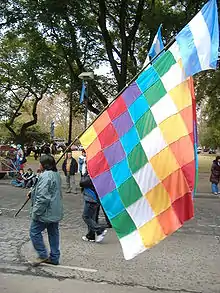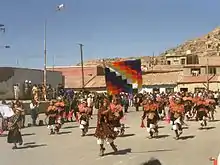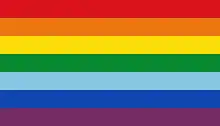Wiphala
The Wiphala (Quechua pronunciation: [wɪˈpʰala], Spanish: [(ɡ)wiˈpa.la]) is a square emblem commonly used as a flag to represent some native peoples of the Andes that include today's Peru, Bolivia, Ecuador and parts of Argentina, Chile and Colombia.
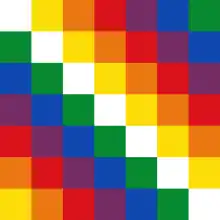
The suyu wiphalas are composed of a 7 × 7 square patchwork in seven colors, arranged diagonally. The precise configuration depends on the particular suyu represented by the emblem. The color of the longest diagonal line (seven squares) determines which of the four suyus (regions) the flag represents: white for Qullasuyu, yellow for Kuntisuyu, red for Chinchaysuyu, and green for Antisuyu. There is also an alternate pattern for the Wiphala for Antinsuyu. Additionally a Wiphala also exists for Tupac Katari and the Tupac Katari Guerrilla Army.
Article 6, section II of the 2009 Bolivian constitution establishes the Wiphala as the dual flag of Bolivia, along with the red-yellow-green tricolor.[1][2]
History
Pre-Columbian era
In modern times the Wiphala has been confused with a rainbow flag which is wrongly associated with the Tawantinsuyu (Incan Empire). There is debate as to whether there was an Inca or Tawantisuyu flag. The oldest surviving example of a wiphala-type design corresponds to a chuspa or bag for coca corresponding to the Tiwanaku culture (1580 BC - AD 1187) 3. The chuspa is currently in the Brooklyn Museum, and its use of wiphala design is mixed with several others, so it is not possible to establish its meaning or use within the Andean cosmogony of the time.
The Museum of World Culture in Gothenburg, Sweden, holds a Wiphala that is dated through a C-14 test to the 11th century. It originates from the Tiwanaku region, and is part of a collection based on a kallawaya medicine man's grave.[3]
Colonial chronicles
There are 16th and 17th-century chronicles and references that support the idea of a banner attributable to the Inca. However, it represented the Incan people, not the empire. Also its origins are from symbols and mural designs found in several civilizations of the Andes with thousands of years of history.
Francisco López de Jerez[4] wrote in 1534:
They all came divided up in squads with their flags and commanding captains, with as much order as the Turks.
(todos venían repartidos en sus escuadras con sus banderas y capitanes que los mandan, con tanto concierto como turcos).
The 17-century chronicler Bernabé Cobo wrote that
the guión, or royal standard [an ecclesiastical processional banner], was a small, square small banner, of about 10–12 hands [palmos is a measure from those times and it refers to a length similar to a hand. Ruedo is the total length of the cloth], made of cotton or woolen cloth, that was carried at the top of a long flagpole, and was stiff, with no wave on the air; each king painted his arms and emblems (badges) on the banner; because each one (king) chose different ones (paintings on his banner), although the common ones among the Incas had the rainbow [sky arch].
(el guión o estandarte real era una banderilla cuadrada y pequeña, de diez o doce palmos de ruedo, hecha de lienzo de algodón o de lana, iba puesta en el remate de una asta larga, tendida y tiesa, sin que ondease al aire, y en ella pintaba cada rey sus armas y divisas, porque cada uno las escogía diferentes, aunque las generales de los Incas eran el arco celeste.)
–Bernabé Cobo, Historia del Nuevo Mundo (1653)
Guaman Poma's 1615 book El primer nueva corónica y buen gobierno shows numerous line drawings of Inca flags.[5]
Colors and their meaning
The seven colors of the actual Wiphala reflect those of the rainbow. According to the Katarista movement[6] (whose interpretation is promoted by the Bolivian authorities[7]), the significance and meaning for each color are as follows:
Andean peoples and social movements
Social movements in Ecuador
Today in Ecuador, it is readily identified with the Indigenous social movement mainly represented by CONAIE (Confederation of Indigenous Nationalities of Ecuador). This organization has had an important role in massive protests in the late 1990s and 2000s. The flag of CONAIE is a wiphala with a mask in the middle from a pre-Inca Ecuadorian coastal peoples known as La Tolita.
The flag is displayed by marches of the CONAIE movement and also it is used by its political faction, the Movimiento de Unidad Plurinacional Pachakutik - Nuevo País (a Pachakutik-inspired Movement), which participates in elections and has a considerable legislative representation. Pachakutik is a Quechua word related with the vision and the hope of a better future for the Andean people. The MUPP was formed in the 1990s mainly by an alliance of the CONAIE with peasant organizations and urban social movements. It also finds sympathy in local LGBT, feminist and Afro-Ecuadorian circles and activists.[8]
The Bolivian Wiphala
The Aimara wiphala is a square flag divided into 7 × 7 (49) squares. The seven rainbow colors are placed in diagonal squares. The exact arrangement and colors varies with the different versions, corresponding to the suyus or Tupac Katari. It is very prominent in marches of indigenous and peasant movements in Bolivia.
This "rainbow squares" flag is used as the pan-indigenous flag of Andean peoples in Bolivia and has recently occasionally been adopted by Amazonian groups in political alliance.
Bolivian president Evo Morales established the Qullasuyu wiphala as the nation's dual flag, along with the previous red, yellow, and green banner in the newly ratified constitution. The Wiphala has been included into the national colors of the Bolivian Air Force such as the executive jet (currently a Dassault Falcon 900EX[9]). The Wiphala is also officially flown on governmental buildings such as the Palacio Quemado and parliament alongside the tricolor since the introduction of the revised 2009 constitution.[10]
During the 2019 Bolivian political conflicts, videos emerged of Bolivian police cutting the wiphala off of their uniforms. It was also removed from some government buildings and burned by protesters, who chanted "Bolivia belongs to Christ!"[11][12] This was later condemned by the acting president, Jeanine Áñez as a destruction of indigenous heritage.[13]
Confusion with flag of Cusco
The Wiphala has been confused with the seven-striped rainbow design flag, the current official banner of the Peruvian city of Cusco, where it is commonly displayed in government buildings and in the main square.[14] This rainbow flag is sometimes displayed as a symbol of the Inca Empire (Tawantinsuyu), although Peruvian historiographers and the Peruvian Congress have stated that the empire never had a flag.[15][16] Although the wiphala is an emblem related principally to the Aymara people, the Inca had their origins with the Quechua people.
Others
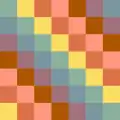 Tupac Katari
Tupac Katari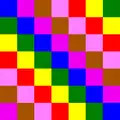 Tupac Katari (alternate)
Tupac Katari (alternate)
See also
References
- "Bandera indígena boliviana es incluida como símbolo patrio en nueva Constitución", October 21, 2008, United Press International.
- Republic of Bolivia, [Text of the proposed] Nueva Constitución Política del Estado, 2007.
- "Carlotta – Objekt". Collections.smvk.se. Archived from the original on 2012-03-15. Retrieved 2013-12-23.
- Francisco López de Jerez,Verdadera relacion de la conquista del Peru y provincia de Cuzco, llamada la Nueva Castilla, 1534.
- Guaman Poma, El primer nueva corónica y buen gobierno, (1615/1616), pp. 256, 286, 344, 346, 400, 434, 1077, this pagination corresponds to the Det Kongelige Bibliotek search engine pagination of the book. Additionally Poma shows both well drafted European flags and coats of arms on pp. 373, 515, 558, 1077. On pages 83, 167–171 Poma uses a European heraldic graphic convention, a shield, to place certain totems related to Inca leaders. There is no evidence of linear (Wiphala-like) patchwork.
- http://www.katari.org/pdf/wiphala
- "Wiphala | Ministerio de Defensa del Estado Plurinacional de Bolivia". www.mindef.gob.bo.
- Inca empire#Organization of the empire
- "Photos: Dassault Falcon 900EX Aircraft Pictures". Airliners.net. 2010-10-24. Retrieved 2013-12-23.
- "Por decreto, el Ejecutivo fija dos fechas fechas de fundación del país". eju.tv. 2010-01-28. Retrieved 2013-12-23.
- Prashad, Vijay (November 13, 2019). "A Bolivian crisis". The Hindu – via www.thehindu.com.
- "When the US Supports It, It's Not a Coup". Common Dreams.
- "Jeanine Añez instruye que junto a la sagrada tricolor se mantenga la wiphala". eju.tv.
- revista.serindigena.cl – Wiphala, Símbolo de la Nación Andina
- Bandera Gay o Bandera del Tahuantinsuyo Terra.com
- "La Bandera del Tahuantisuyo" (PDF) (in Spanish). Retrieved 12 June 2009.
External links
| Wikimedia Commons has media related to Wiphala. |
- Wiphala Emblems
- Emblema Nacional del Pusinsuyo = Tawantinsuyo
- History of Wiphala
- "Guaman Poma – El Primer Nueva Crónica Y Buen Gobierno" – A high-quality digital version of the Corónica, scanned from the original manuscript. Has numerous line drawings that illustrate both Inca flags and Spanish flags.
